Frost Protection for Fruit Trees
Spring is a busy time for fruit trees. The buds are swelling, pulling energy from the root system, and erupting into full bloom, ready to produce this year's bountiful harvest. As homeowners, it's satisfying to watch the trees begin growing for the season. However, spring weather can be unpredictable, bringing the threat of frost that can damage your crop. Fortunately, there are ways to protect the trees from a late spring freeze.
Factors to consider
Several factors determine the likelihood of frost damage on your trees. These include:
- Temperature
- Types of Frost/Freeze Events
- Location
- Stage of Bud Development
- Site Selection
- Cultivar
Temperature plays a significant role in evaluating the risk of frost, but the relative humidity is also essential. Frost usually forms when the dew point (relative humidity reaches 100%) is below freezing, and the air temperature is above freezing. When the dew point is above freezing, there is typically more water in the air, which takes longer to cool, preventing frost formation at temperatures above freezing. A dew point below freezing creates drier air, which cools quicker and allows frost to form at temperatures above freezing. The resulting frost forms on surfaces like grass and cars because the surface temperature is colder than the air. A freeze occurs when the air temperature falls below 32 degrees. It's essential to monitor your local weather forecast to determine the risk of frost or freeze event in your area.
There are two types of frost/freeze events:
- Radiation Frost
- Advective Freeze
Radiation frosts occurs when skies are clear and the air is still. During a radiation frost, branches on the top and outer part of a fruit tree are more susceptible to damage than the interior. The air temperature inside the tree canopy can be slightly warmer than the more exposed tips. Radiation frost is most severe when a cloudy day becomes a clear night due to quick temperature drops. Radiation frost only lasts a few hours but can damage fruit trees in this short time. There are several ways to protect fruit trees during this type of frost and usually include some sort of temporary cover and/or heat source.
Advective freezing can last several days and involves air temperatures below freezing. Advective freezes are often accompanied by strong winds, clouds, and precipitation. The aggressive nature of advective freezes make it challenging to protect fruit trees. Advective freezes are more common in fall than they are in spring.
The location of your yard influences the likelihood and severity of a freeze. The terrain surrounding your property will have a significant impact on the temperature. One thing to remember is cold air sinks and warm air rises. It's not uncommon for the growing season at the bottom of a valley to be shorter than in the areas at the top. In addition, urban areas often experience a heat island effect, raising the temperatures enough to limit mild frost events. Understanding how cold air moves can help you learn about the micro-climates around your property so you can better prepare your trees for a frost event. In addition to topography, other conditions like, evergreen wind breaks, and man made structures can all protect fruit trees from advective freeze events.
Bud development plays a major role in in the likelihood of freeze damage. Flower buds that are blooming or finished blooming are more susceptible than buds in earlier stages of development. Follow this link to see Utah State University's chart on frost sensitivity of buds at different stages of development, along with damage levels reported at different temperatures below freezing. The rate of bud development varies each year based on weather, but there are a few ways to minimize frost damage on your trees.
Site selection can impact when your fruit trees bloom. Planting trees along the southern side of a house, for example, may cause them to bloom earlier, putting them at higher risk of frost damage. As mentioned earlier, placing trees in low areas of the yard also increases the risk of frost damage. Ideally, trees are located on a sheltered incline, allowing cold air to drain away from your trees.
Choosing the right tree for your climate can save you a lot of grief when it comes to frost and fruit production. Modern breeding efforts allow breeders to select desirable characteristics for fruit trees, such as bloom time. Planting cultivars that bloom later can reduce the risk of frost damage to your trees.
Frost Preparation
You've been monitoring the weather and frost is in the forecast. Now what? It is time to make a plan of action for protecting your fruit trees. You can utilize several methods of protection. The size of the tree and the type of frost will determine the best types of protection.
For more information about the care and pruning of fruit trees, subscribe here!
An effective way to protect young trees is to cover them. Several types of materials are suitable for this type of protection. Polyester frost blankets, sheets, and blankets work effectively. You shouldn't use plastic because it traps moisture on the inside of the covering, causing damage to buds that touch the plastic. Covers should be placed on the tree during the late afternoon while temperatures are well above freezing. this allows heat from the ground to be absorbed inside the covered area. when covering your trees keep the base of the cover several feet from the tree base on all sides. This will keep warm air inside the covering and around the entire tree. The edges of the cove can be secured using heavy objects placed on the ground.
A good practice to consider is irrigating the tree before a frost. Irrigation should happen the day before frost is forecasted. Moist soil takes longer to cool and releases heat as the temperature drops, creating slightly warmer temperatures around the trees.
Advective freezes are less common in spring, but they can be an occasional problem. Lighter materials used to protect during a radiation frost may not be as effective during an advective frost due to wind. Covering trees with a combination of polyethylene and blankets offer a stronger defense during an advective freeze. Additional protection can be provided using a source of heat, such as a floodlight or mechanic's light. The lights can be placed on the ground under the tree. If using lights, inspect the wiring to check for shorts and ensure no moisture can enter the light fixture or wire connections. If using light make sure they are not LED type bulbs, these lights do not emit enough heat to affect frost.
Mature trees can resist frost damage better than young trees, giving them an advantage during frost events.
Homeowners can cover trees, but in commercial settings the materials and labor involved in this method is cost prohibitive. Irrigating an orchard continuously when temperatures are below freezing can release heat as the water transitions from liquid to ice. While this method is primarily used in orchards, it can be effective in home landscapes but should be used cautiously. Too much water on your trees can lead to broken limbs, while insufficient water may not offer enough protection during a frost event.
If you would like to learn more about the care and pruning of fruit trees, please browse our 100+ fruit tree articles here, join our Backyard Fruit Growers Facebook Group, and take our free Fruit Tree Pruning Course. Also, please subscribe to our Fruit Pruning YouTube Channel.

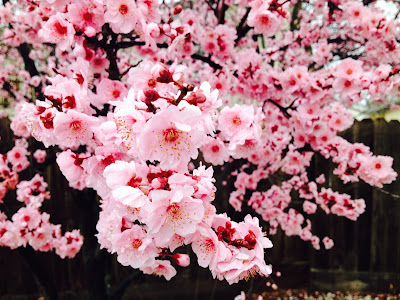


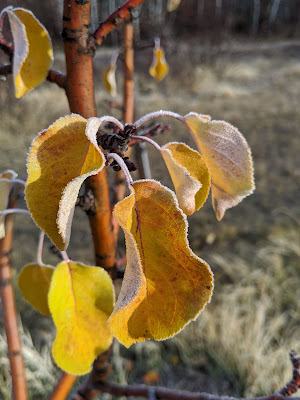
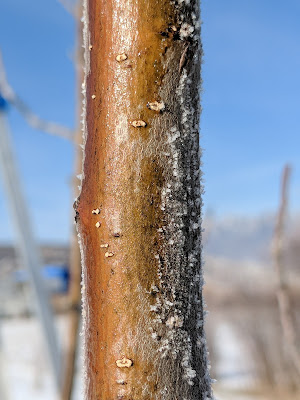
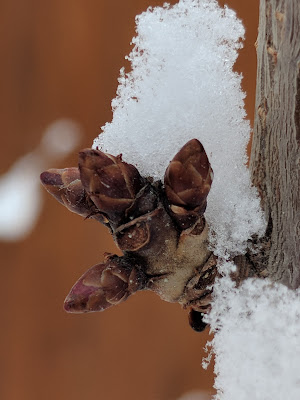
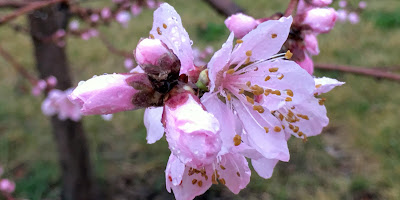



This is excellent and very helpful information! Thanks so much.
ReplyDeleteGlad to help!
ReplyDelete